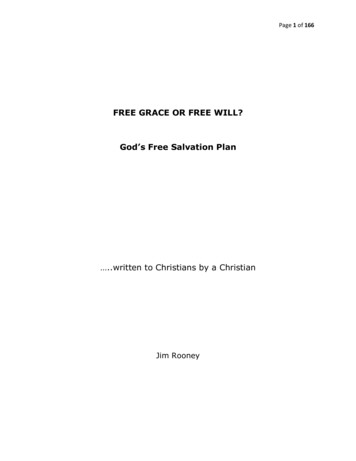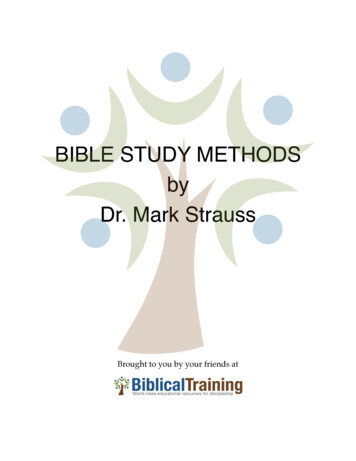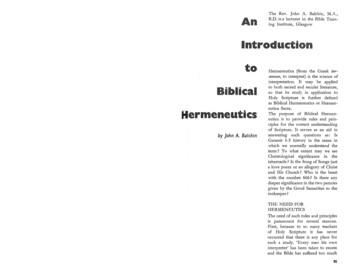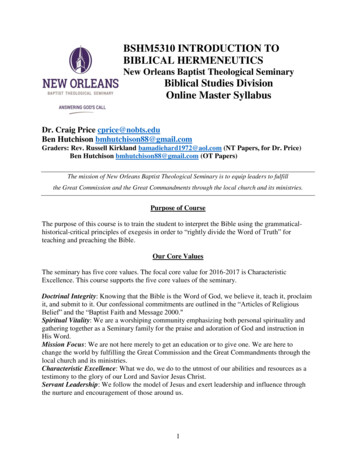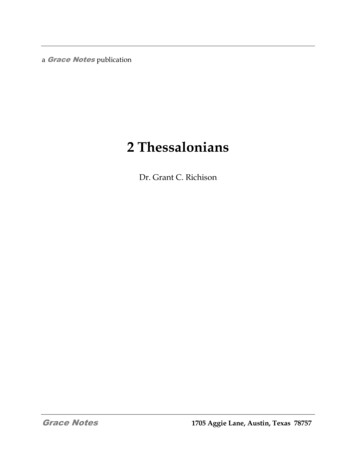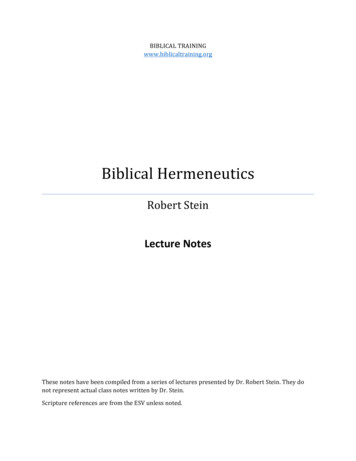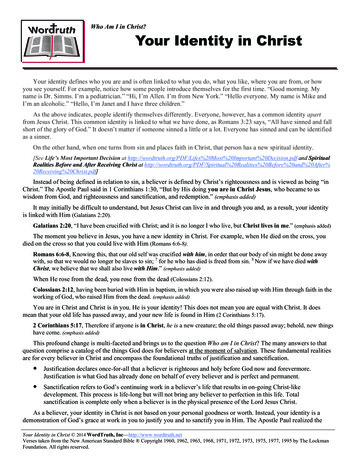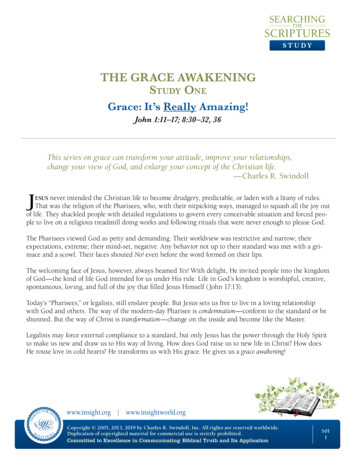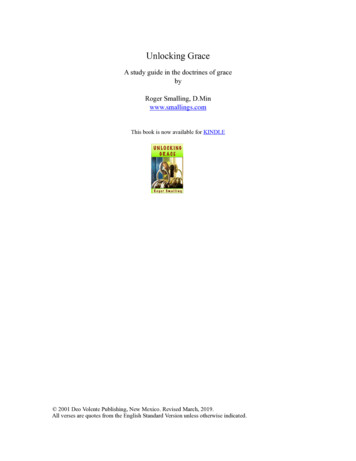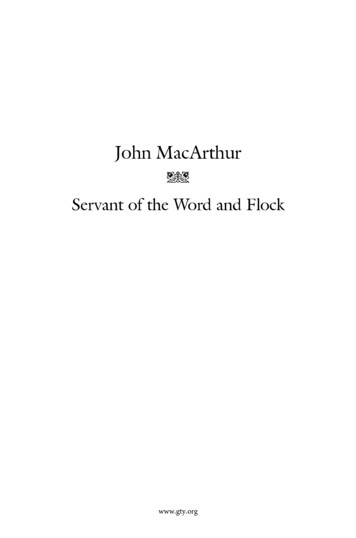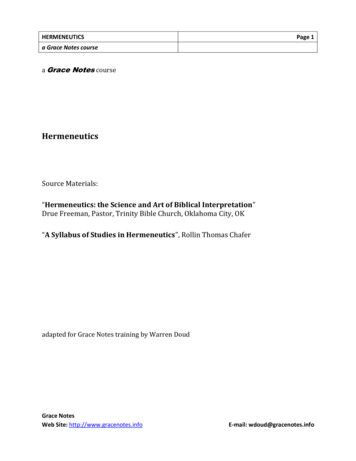
Transcription
HERMENEUTICSPage 1a Grace Notes coursea Grace Notes courseHermeneuticsSource Materials:“Hermeneutics: the Science and Art of Biblical Interpretation”Drue Freeman, Pastor, Trinity Bible Church, Oklahoma City, OK“A Syllabus of Studies in Hermeneutics”, Rollin Thomas Chaferadapted for Grace Notes training by Warren DoudGrace NotesWeb Site: http://www.gracenotes.infoE-mail: wdoud@gracenotes.info
HermeneuticsA Grace Notes courseContentsLesson 1 - Preface and Introduction . 2Lesson 2 - Historical Schools - Allegorists . 6Lesson 3 - Historical Schools-Literalists . 8Lesson 4 - Historical Schools - Liberals . 10Lesson 5 - The Protestant System Of Hermeneutics - Introduction . 18Lesson 6 - The Protestant System Of Hermeneutics – Theological Perspectives . 22Lesson 7 - The Protestant System Of Hermeneutics - Grammatical Perspectives . 23Lesson 8 - The Doctrinal Use Of The Bible . 25Lesson 9 - The Devotional And Practical Use Of The Bible . 27Lesson 10 - Inerrancy And Secular Science the Issue Of Infallibility And Inerrancy . 29Lesson 11 - Types, Symbols And Parables. 35Lesson 12 - The Interpretation Of Prophecy . 41Lesson 13 - The Use Of The Old Testament In The New Testament. 45Lesson 14 - The Hermeneutics Of Logic . 46Lesson 1 - Preface and IntroductionThis Bible study course is designed to acquaintthe serious student of the Word of God withequipment that will help in the interpretationof the Scriptures.We are going to begin with an introduction tothe various schools of hermeneutical thoughtand then proceed to the various principles thatare used in the Protestant system of Biblicalinterpretation.The approach that will be used is based on thepersonal belief of the author that the Scripturesare totally and completely inspired by God andthat He communicates to His people that whichHe desires them to know.We will not only explore the basic principles ofinterpretation, but will also consider somespecialized areas such as symbols, types,parables and prophecy.Please begin and end this course with prayer,praying as you go. Seek to know God's Wordfor He has promised that you can (Matt 7:7-8;James 1:5), but more than just knowing God'sWord, seek to know Him (Phil. 3:10) in a morepersonal and intimate way for many haveknown His Word, but did not really know theFather (John 5:39-45).All Scripture quotations are taken from theNew American Standard Bible published by theLockman Foundation.This study course was derived from class notesgleaned from Dr. Dale Carnagey of TulsaSeminary of Biblical Languages in the fall of1978, our textbook, Protestant BiblicalInterpretation, by Bernard Ramm (Baker BookHouse, 1970), and Drue Freeman personalteaching notes.
HERMENEUTICSPage 3a Grace Notes courseIntroductionThe Qualifications of an Interpreter:Hermeneutics is the science and art of Biblicalinterpretation. It is a science because it isguided by rules. The art is in the application ofthe rules.The primary need of hermeneutics is todetermine the meaning of the Word of God.Since all doctrine rests upon interpretation, wemust have correct interpretation to developcorrect doctrine.Hermeneutics seeks to bridge the gap betweenour minds and the minds of the Biblical writers.The best way to accomplish this bridge isthrough a thorough knowledge of the originallanguages, ancient history and comparison ofScripture with Scripture. An extensiveknowledge of geography and culture is alsoinvaluable.The step of faith that we must make is theinspiration of Scripture (2 Tim 3:16). Thisestablishes the boundaries for correctunderstanding of the Word.We also must seek to determine the true text.This discipline is called textual criticism. Lowercriticism seeks to determine the author anddate of the writing. So called “Higher Criticism”is a liberal approach to Scripture that does notaccept complete inspiration of the Bible.There is a need for intellectual honesty andeducation. One may have the rules memorized,but may not be able to apply them, or may seekto apply them in a biased manner. Theobjective of the interpreter is to read out of thetext (exegesis) not to read one’s ownviewpoints in to the text (eisegesis). One wayto become as objective as possible isprayerfully and thoughtfully consider any andall alternatives in a given passage.Interpreters should approach the text inhumility, meaning that the interpreter must beteachable and realize that he should never stoplearning. Interpreters must also recognize thatinspiration (which comes from God) isinfallible, but personal illumination is not.1. One must be a Believer because correctinterpretation requires the work of theHoly Spirit. 1 Cor 2:14-162. One must be filled with the Holy Spirit. Eph5:183. One must possess a desire to know. Matt7:7-84. One must be seeking to correctly interpretGod’s Word. 2 Tim 2:155. One should have some spiritual educationover a period of time. 1 Tim 3:6Introduction by Rollin ChaferBiblical Hermeneutics receives scant attentionin the modern theological curriculum. Evenbefore the time of the virtual abandonment byliberal seminaries of the idea that theScriptures are the authoritative source ofChristian dogmatics, the study of Hermeneuticswas relegated mostly to the department of OldTestament. At the same time, it too oftendegenerated into an arbitrary classification offavorite interpretations which were dictated byaccepted creedal dicta, rather than by theapplication of the laws governing logicalinterpretative procedure. It seems certain thatthe thought that Hermeneutics as a science hasto do with the mastery and the applicability ofthe laws governing interpretation was too oftenforgotten.Terry does indeed draw a distinction betweenHermeneutics as a science engaged with thestudy of the governing laws, on the one hand,and Hermeneutics as an art concerned with theconcrete application of the laws, on the otherhand; but the latter seems to me to be butanother description of exegetical praxis. In theclosing words of his first chapter Terry sensesthis when he says: “For if ever the divinelyappointed ministry of reconciliation accomplishthe perfecting of the saints, and the building upof the body of Christ, so as to bring all to theattainment of the unity of the faith and of theknowledge of the Son of God (Eph 4:12, 13), it
HERMENEUTICSPage 4a Grace Notes coursemust be done by a correct interpretation andefficient use of the word of God. Theinterpretation and application of that wordmust rest upon a sound and self-evidencingscience of hermeneutics.”Perhaps no widely quoted hermeneut has moreconsistently emphasized the essential fact thatBiblical Hermeneutics is, first of all, a study ofthe laws which govern sound Biblicalinterpretation than the late M. Cellérier,Professor in the Academy of Geneva,Switzerland, whose Manuel d’HermeneutiqueBiblique was in large part made available toAmerican readers in a translation and revisionby Elliott and Harsha, published in 1881. In thefirst four chapters of his work he reiterates andemphasizes this definition at the beginning ofeach section as though he were seeking tocombat an erroneous conception of the science:“Hermeneutics is the science which furnishesthe true principles of interpretation.”We must insist again that Hermeneutics is not acollection of favorite interpretations gleanedhere and there from a bibliography ofinterpretative writings. A hermeneut is onewho, through familiarity of the laws governingsound procedure in the interpretation of theScriptures, is thereby enabled to test any and allinterpretations of the Word of God presented tohim. Apart from this thorough understanding ofthe governing laws he must be dependent uponthe opinions of other men.The necessity of being guided by sound laws issharply brought out by Lockhart in the secondchapter of his Principles of Interpretation,wherein he lists fifteen axioms, one of which ishere cited: “The true object of interpretation isto apprehend the exact thought of the author.”On this Dr. Lockhart comments: “It is not theprivilege of any interpreter to impose his ownthought upon the words of an author, nor inany way to modify the author’s meaning.” Themoment that one allows himself this privilegehe ceases to be an interpreter and becomes acollaborator with the author. To essay this rolewith the Spirit Author of the Scriptures shouldgive pause to a larger number of carelessinterpreters than is daily evident.Several standard works on Hermeneuticsdescribe the relative place this science occupiesin Theological Encyclopedia and Methodology.One of the most concise statements is made byCellérier and is as follows:“(a) The Christian divine, called to expound andinterpret the Word of God, ought first to explainthe history, the circumstances, and the form ofthe Bible. This is the first object of Introduction,or Isagogics. [This is often called the HigherCriticism, and the student should keep in mindthat there is a vast field of constructive highercriticism as well as the destructive variety. Theterm, “higher criticism” should be used withqualifying adjectives].“(b) He must, in the second place, determine, asnearly as possible, the true and original text;and endeavor to disengage it from thenumerous variations with which eighteencenturies of citations and transcriptions haveencumbered it. This is the object of theCriticism of the Text.” [Often called the LowerCriticism].“(c) Before attempting the explanation of thephrases and ideas of the Bible, a third test, andthe most important of all, is necessary. Thetheologian should understand the principles,according to which they must be explained. Theexposition of these principles receives thename of Hermeneutics.”“(d) After these three successive processeshave been finished, the Biblical interpreterenters upon his work. He reads, he analyzes, hedevelops, he comments on the Holy Word, lineafter line. He no longer constructs a science; hepractices an art-Exegetics: he accomplishes atask - Exegesis.”Although the word Exposition is often used as asynonym for Exegesis, in popular usage it ismore often used to represent the popular
HERMENEUTICSPage 5a Grace Notes courseplatform presentation of the results ofexegetical study.In the field of Biblical interpretation there aretwo principal methods of procedure:(1) that which functions inductively within thesphere of the Scripture testimony; and(2) that which approaches the Scriptureswholly or partly from without, and which isdeductive in method.It was a favorite classroom saying of the late Dr.B. B. Warfield that “all theologies divide at onepoint - does God save men or do they savethemselves?” As truly it may be said that allsystems of Bible interpretation divide at onepoint-is the Bible a self-interpreting book ordoes it require a humanly contrived system ofinterpretation in order to be understood? Inother words, does the Bible contain its ownhermeneutical laws which are sufficient, andcapable, when rightly understood and followed,of guiding the student to a correctinterpretation of its own disclosures: or is itdeficient in such interpretational provisions,and therefore dependent upon the resources ofhuman reason to supply that lack?Intelligently or unintelligently, Bible students ingeneral follow the principles of one or the otherof these alternative systems, either wholly or inpart. It is a startling fact that many studentswho assert their belief that the Bible isrevelation from God, divinely inspired, acceptthe latter alternative without realizing itslogical implications. To hold that humanreason-and how often the phrase occurs inconnection with this or that interpretation, “it isnot reasonable in the light of present-dayknowledge”-is the final arbiter, even in mootquestions, leads to definite experimental resultsin the student himself and eventually leads tothe conclusion that it is admissible toaccommodate particular Scripture passages toharmonize with extra-Biblical hypotheses.Writing concerning the work of the students atthe Harvard Medical College, Jerry McQuadesaid: “Psychologists classify men into twotypes-the type which accepts whatever is toldto them as a predigested compendium of allthat they should know, and never ask anyfurther questions; hence quietly pass intooblivion, and the type, which feels the impulseof life and the thirst to ask why, wherefore,whither, how; hence etch deep on the tablet oftime for the ages to come.”There are two groups of theological studentswhich may be classed under Mr. McQuade’sfirst type. The first group comprises those whoaccept without question what they are taughtby heterodox teachers. The members of thisgroup, with few exceptions, become ministersof mere human righteousness, and thereforetools of Satan.The other group represents those who,professing orthodoxy, also follow the line ofleast resistance and adopt without questioninterpretative teachings, furnished inpredigested form, which may or may not havebeen formulated in accordance with sound lawsof Biblical interpretation. Failing to gain a firsthand experience in the application of thefundamental principles of Biblicalhermeneutics by which they may test theScripturalness of all teachings, the members ofthis group become mere echoing mouthpiecesof other men’s theological and creedal opinions,a state which is intolerable to an honeststudent, and one which is destructive of selfrespect, intellectual and spiritual.In schools of theology, as in other technicalinstitutions, here and there are found studentswho may be classified under Mr. McQuade’ssecond type, diligently seeking the Biblical“why, wherefore, whither, how,” of everyteaching, not content with the rumination ofpredigested theological dicta. Bringing to theirtask believing hearts and a dependence uponthe illumination of the Spirit Author, they trulyprepare to “etch deep on the tablet of time.”Moreover, as in the case of no other class of
HERMENEUTICSPage 6a Grace Notes coursetechnicians their work is peculiarly preservedto shine not only during time but in eternity.Biblical interpretation, in contrast to thesystems dictated by human reason, isinextricably bound up with intelligent andacceptable Christian service. There is no appealto human reason in Paul’s word to Timothy:“The husbandman that laboreth must be firstpartaker of the fruits. Consider what I say; andthe Lord give thee understanding in all things”(2 Tim 2:6, 7). It is indeed true that the Lordgives the understanding, but he imparts thisrichly to those who, with believing hearts, heedthat further injunction to Timothy: “Study toshew thyself approved unto God, a workmanthat needeth not to be ashamed, rightly dividingthe word of truth” (v. 15).Exercises1. Why is the study of Hermeneutics both ascience and an art?2. What is the primary need of Hermeneutics?3. What is the best way to bridge the gapbetween my mind and the mind of thewriter?4. What is the "step of faith" that I must taketo begin to interpret the Scripture?5. Is my interpretation infallible? Explain.6. Do I fit the qualifications for an interpreter?If not, why?Lesson 2 - Historical Schools AllegoristsGeneralAn “Allegory” is a symbolic representation.There were schools of interpretation that tookthe literal words of Scripture and assumed thatthey were symbolic of deeper spiritual truths.While there are some obvious symbols in theWord of God such as in Ezekiel 1, it would be ahuman assumption to claim that all of Scriptureis symbolic and that the literal has nosignificant meaning.Greek Allegorical Schools:The Greek Allegorical Schools were concernedonly with their own writings, but their methodof interpretation was adopted by both Jews andChristians. Their philosophical and historicaltraditions which were stated by Thucydidesand Herodotus were always at odds with theirreligious traditions which were stated byHomer and Hesiod. They relieved the tensionby allegorizing the religious.Jewish Allegorical Schools:The major writers for the Jewish AllegoricalSchool were Aristobulus (160 BC) and Philo (20BC - 54 AD). Philo tried to reconcile theHebrew faith with Greek philosophy. Theseallegorists claimed that the literal was for theimmature.The Jewish Allegorists developed Canons (aregulation or standard) for allegoricalinterpretation that told them when they wereto interpret in this manner. If they found astatement that was “unworthy” of God, orstatements that either seemed to contradict orin any way presented a difficulty, they felt freeto interpret allegorically. Also, if the recorditself was allegorical in nature or they ran intogrammatical peculiarities or symbols theyturned to allegory.Christian and Patristic Allegorists:The Christian and Patristic Allegorists believedthat the Old Testament was a Christiandocument but considered it to be full ofparables, enigmas, and riddles. They alsoignored the historical connections of scriptureand believed that Greek philosophy was to befound in the Old Testament.One of the major writers was Clement ofAlexandria (c.150 A.D.) who claimed that therewere five possible meanings. The Historicalmeaning which concerned the actual event; TheDoctrinal meaning which included moral andtheological teachings; The Prophetic meaningwhich was concerned with predictions andtypes; the Philosophical meaning which seesmeaning in objects and historical persons; and
HERMENEUTICSPage 7a Grace Notes coursethe Mystical meaning which involved deepermoral, spiritual or religious truth found viasymbols.Origen was a student of Clement who sought toescape the crudities of lay people by takingeverything symbolically. He tried to makescripture acceptable to philosophers. Origen’sapproach was threefold in that the Literalmeaning was the Body of Scripture, the Moralsense was the Soul of Scripture, and theAllegorical sense was the Spirit of Scripture. Hebelieved that true exegesis was Spiritual(allegorical) exegesis.Jerome (347-420) translated the Bible intoLatin and that translation is called the Vulgate.It has been the only official Bible of the RomanCatholic Church since the Council of Trent in1545. Jerome suggested that the Apocrypha beput in Bible.Augustine sought to develop a theory of signs.A sign is a thing apart from the impression thatit presents to the senses and which causes ofitself some other thing to enter our thoughts.He based his position on 2 Cor 3:6 which says“who also made us adequate as servants of anew covenant, not of the letter, but of the Spirit;for the letter kills, but the Spirit gives life.”Augustine’s requirements for properinterpretation were: 1) an interpreter must bea believer; 2) the literal meaning and historicalsetting must be held in high regard; 3)Scripture has a double meaning, therefore theAllegorical method is proper; 4) recognize thatthere is significance in numbers; and 5) the OldTestament was a Christian document and Christshould be sought there. Augustine believedthat true exegesis had to consult the meaning ofthe writer, then the “analogy of faith” which isfound in the true orthodox creed and add love,which is spiritual intuition.Some of Augustine’s other teachings were: 1)that one had to pay attention to the context; 2)if the interpreter is insecure in his basic beliefs,he can’t be part of the orthodox faith; 3) thatone must not try and make the Holy Spirit asubstitute for the tools; 4) that the obscurepassage must yield to clear; and 5) that onemust also note progressive revelation within itshistorical context (some say that he failed toapply this point himself).Roman Catholic School:The Allegorism of Roman Catholicismemployed a “spiritual” or “mystical”interpretation of the Word. In general, theRoman Catholics combined Typology andAllegory and sought the Moral Interpretation.They believed that the literal and historicalinterpretation is the foundation of the study ofthe Bible, but that the “spiritual” or “mystical”meaning, which is beyond the literal, is what weshould really seek.The Roman Catholics use the Latin Vulgate (aLatin translation by Jerome from the Hebrewand Greek) as though it were the original text.The Catholic interpreter accepts what TheChurch has said about various matters asunequivocal truth. They believe that TheChurch is the official interpreter since The Bibleis not given to the world but deposited with theChurch. Also at the heart of their beliefs is thatthe Christian Deposit of Faith is in the CatholicChurch. Therefore, no passage of Scripture canbe validly interpreted in a manner that conflictswith the Roman Catholic Doctrinal system.Their view of the “analogy of faith” is tocompare a particular interpretation withChurch Dogma.The Roman Catholic “Guide to Interpretation” isthat interpretation: must be solely about faith and morals. is not bound by national or scientificmatters. must bear witness to Catholic tradition. must have a unanimous witness by theChurch Fathers. is to be explained by unwritten traditionwhen the passage is obscure. follows the “Principle of Development”meaning the doctrines of the New
HERMENEUTICSPage 8a Grace Notes course Testament were ‘seeds’ and not completeunits in themselves.also follows the “Principle of Implication”which is called “Epigenesis” meaning thatdoctrines grow, develop and change.For Personal Study1. What is an allegory?2. What is the major assumption of theAllegorical School of thought?3. From which Allegorical School did both theJews and Christians get their foundation?4. How did the Jewish Allegorical Schooloriginate?5. How do Allegorists view Literalists?6. What were the five possible meanings ofScripture according to Clement ofAlexandria?7. What were the body, soul and spirit ofScripture according to Origen?8. Evaluate the basic teachings of Augustine.9. Discuss the basic hermeneutical system ofRoman Catholicism.Lesson 3 - Historical Schools-LiteralistsGeneral:The literal method of interpreting the Bible is toaccept as basic the literal rendering of thesentences unless by virtue of the nature of thesentence or phrase this is not possible. Thisallows for figures of speech, fables andallegories. When reasons exist for somethingbeyond the literal meaning, there must be sometype of control.Jewish Literal SchoolEzra founded this school when he translatedthe Hebrew to Aramaic for the Jews who werecoming out of captivity (Neh 8:1-8). The JewishCanons of interpretation were that: the Word is to be understood in terms ofsentence and the sentence by its context. one should compare similar topics ofscripture and give the clear passagespreference over the obscure. one must pay close attention to spelling,grammar, and figures of speech. Logic is be used to apply scripture to life incircumstances where the Bible is silent.The Literal school recognizes the Divineaccommodation of Revelation to men.Some Problems in the Literal School:The “hyperliteralists” who are also called“letterists” took things to the extreme and wereconstantly looking for hidden meanings lying“under” the surface of the text.The Cabbalists (Kabbalists) often allegorizedthe letters. They used notarikon where eachletter stood for another word. They also used amethod called gemetria which assignednumerical values to words, and then comparednumbers and a system called termura whichchanged the letters of words to form newwords.Syrian School of AntiochThe Syrian School of Antioch avoided letterismand allegories. Lucian and Dorotheus werefounders, around 325 A.D. Arius and Eusebiusstudied at this school. Diodorus who was thefirst presbyter of Antioch until 378 AD, then theBishop of Tarsus, also was part of the school atAntioch. There exist many extant writings fromthe students of this ancient school.Theodore of Mopsuestia was a student ofDiodorus who was intellectual and dogmatic.He denied the inspiration of some books of theBible, but he also denied Allegory.John Chrysostom who was also called “thegolden-mouthed” was a talented exegete andcommunicator who recognized inspiration andtotality of the Canon.This School debated Origen’s Allegorical school.The Syrian School: recognized a plain-literal and a figurativeliteral sense of Scripture.
HERMENEUTICSPage 9a Grace Notes course were not “letterists.”avoided the authoritarian exegesis of theRoman Catholics. insisted on historicity of Old Testamentevents. related the Old Testament and NewTestament Typologically, not Allegorically. recognized Progressive Revelation. held that the bond between the OldTestament and New Testament is prophecy.This is the line of descent passed through by thewriter of this course.The Victorines:The major representatives of The Victorineswere Hugo of St. Victor, Richard of St. Victor,and Andrew of St. Victor. They noted theimportance of history and geography, which isthe natural background for literal exegesis.They emphasized syntax, grammar andexegesis and did not get involved in letterism.The Reformers:The Reformers based their approach on thephilosophical system of Occam. This systemfirst separated Grace and Nature and saideverything we know about God is via DivineRevelation. The second factor involved arenewed study of Hebrew and Greek. Erasmuspublished the first Greek New Testament in1516.The Reformer Martin Luther held the followinghermeneutical principles: The Psychological Principle whichrecognized faith and illumination. The Authority Principle which held that theBible is the supreme authority and is abovechurch authority. The Literal Principle, which rejectedallegory as, used by the Catholics. (Theywere not adverse though if the context wereChrist and not something about thepapacy). They accepted the primacy of theoriginal languages and paid attention togrammar, time frame, circumstances,conditions, and context. The Sufficiency Principle, which indicatesthat the Bible is a clear book and a devoutstudent, can understand it. This includesthe fact that Scripture interprets scripture,so one must let the clear interpret theobscure. They also employed the "Analogyof Faith" which was believed to be thetheological unity of the Bible and not therecognized dogma of an institution. The Christological Principle states that thefunction of all interpreters is to find Christ.(The Roman Catholics seek to do this withAllegory) The Law-Gospel Principle which recognizesthat the Law is not necessary for salvation.In the Post-Reformation Era Ernesti publishedInstitutio Interpretis in 1761 which stated thatgrammatical exegesis had authority overdogmatic exegesis which was the RomanCatholic method.Devotional Schools:This group emphasizes the edifying aspects ofScripture as per 2 Tim 3:16. The MedievalMystics who used the Scriptures to promote themystical experience led this school. TheVictorines fell into this category.PietistsThis was started by Philip Spener (1635-1705and August Francke (1663-1727) whoattempted to recover the Bible as spiritual withthe intended use of edification. It was areaction against those who read the Bible onlyto tear down others. Bengel was the chiefexponent. The Pietists emphasizedgrammatical and historical interpretationseeking to apply it to life.The Pietists influenced the Moravians. Thisevangelical movement can be traced to Moraviaand Bohemia (Czechoslovakia). Count vonZinzendorf (1700 - 1760), the leader of theBohemian Brethren was a part of theDevotional School. The Pietists also influenced
HERMENEUTICSPage 10a Grace Notes coursethe Puritans including John Wesley, JonathanEdwards, Mathew Henry, and the Quakers.The problem they faced was one of having onlypious reflections of Scripture without clearexplanations. The Modern Devotional Schoolclaims devotions are absolutely necessary asChristians need applications to live by. Theweaknesses of this school are that it can easilyfall prey to Allegory, and often, pious reflectionsare substituted for valid exegesis.For Personal Study1. Describe the Literal approach to God'sWord.2. What were some of the problems in theLiteral School and why would they beproblems?3. Which Literal School debated Origen'sAllegorical School and who were some of itsfamous students?4. Discuss the principles held by the SyrianSchool.5. Discuss Luther's principles of hermeneutics.6. Discuss the strengths and weaknesses ofthe Pietists.Lesson 4 - Historical Schools - LiberalsThe Liberal School of interpretation grewprimarily out of the debate betweenrationalism and authoritarianism. Whateverwas not in harmony with ‘educated’ moralitywas rejected.The Liberal system of hermeneutics is that: The Modern Mentality was to govern one’sapproach to scripture. The Bible is just another book. Miracles are not to be accepted becausethey are not scientific. Hell, sin, and depravity are rejected becausethey offend moral sensitivities. The text may be rearranged. They reject all forms of Inspiration. Revelation is redefined to mean humaninsight into religious truth. Doctrinal and theological content are notbinding. They believe that religious experien
Introduction Hermeneutics is the science and art of Biblical interpretation. It is a science because it is guided by rules. The art is in the application of the rules. The primary need of hermeneutics is to determine the meaning of the Word of God. Since all doctrine rests upon interpretation, we mus

